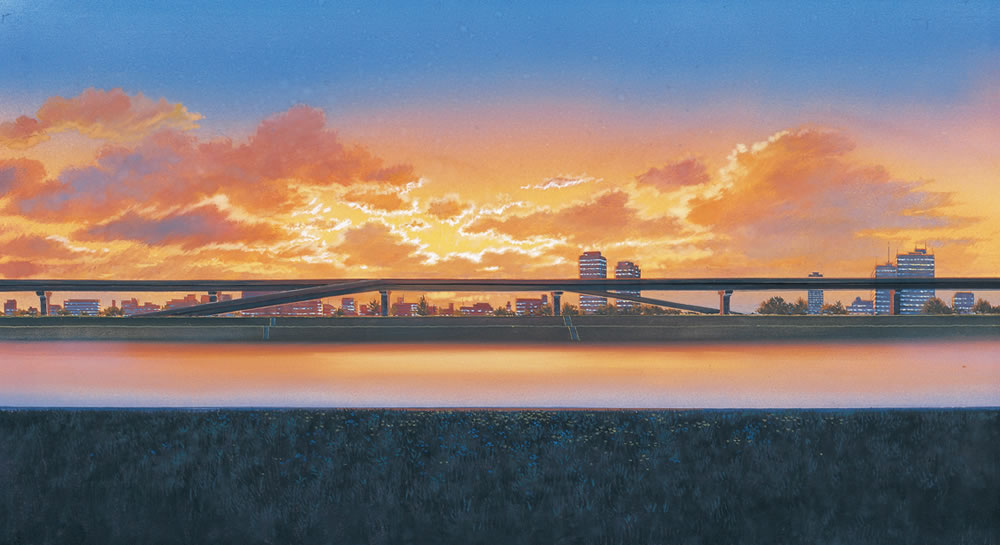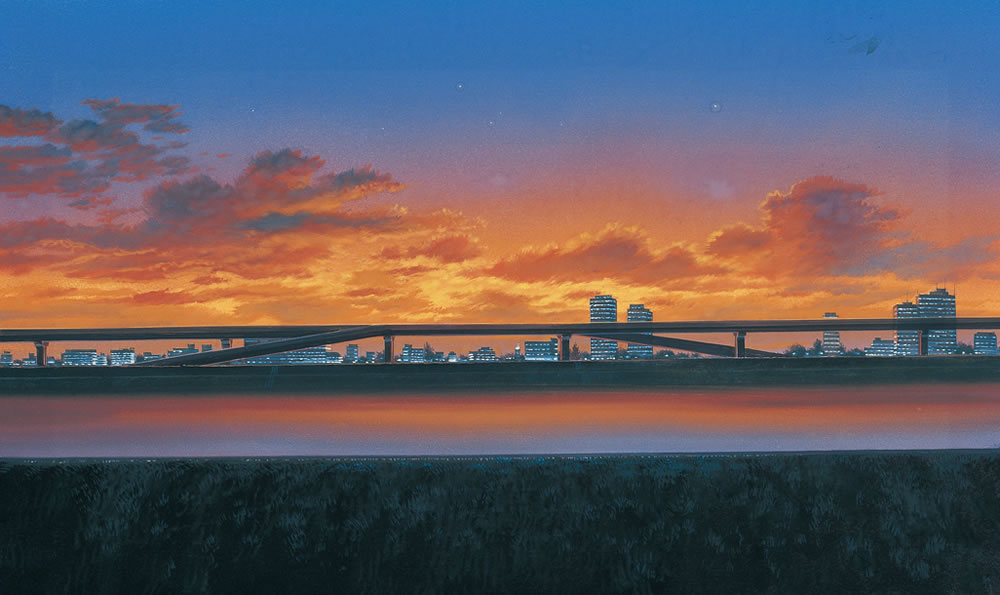Nizo Yamamoto (1953-2023)
August 20, 2023 · 0 comments

The background artist Nizo Yamamoto, who died on 19th August, spent his whole life working in the Japanese animation sector. Born on the Goto islands in Nagasaki Prefecture, he developed an interest in painting and architecture at school before studying at the Tokyo Designer Gakuin. He was not yet out of college when he found his first jobs in anime, and his early career saw him move from the art studio at Toei to Nippon Animation. Subsequently, he became an integral part of the look and feel of some of Japanese animation’s greatest movie hits, responsible for many stunning “anime skies”.
His first job as art director was on Nippon Animation’s Future Boy Conan, on which the director, a stickler called Hayao Miyazaki, made his life miserable by piling on the workload in creating the Giganto super-plane.
“Painting the backs of the cels of the Giganto – that isn’t the art section’s duty, but Miyazaki brought me the lot,” Yamamoto recalled. “I was already overwhelmed with the art job, but he gave me the additional task. The Giganto is detailed and I had to do it very carefully. And there were so many [cels] that after painting after painting, there were still more. I guess there were about seventy or eighty pieces altogether. The work I was supposed to be doing was pushed back and I was so frustrated… I never ever want to see the Giganto again.”
His reward was to be poached by Miyazaki when the director left Nippon Animation, working on Lupin III: The Castle of Cagliostro and Isao Takahata’s Jarinko Chie. Thereafter, Yamamoto would often be the default art director and scenic painter for the two men who would go on to become animation superstars.

He moved to Studio Ghibli at Miyazaki’s urging to work on Laputa: Castle in the Sky, where the director pressed him to draw a “dragon’s nest” cloud formation that endured in the sky from dusk until dawn. Nizo would later recall that he had protested such a cloud would collapse at night, only for Miyazaki to cut him off: “It doesn’t matter. A typhoon is approaching and it is animation.” He also noted, somewhat grumpily, that owing to climate change, Miyazaki was now right, and such clouds could be seen at night.
As an artist on Takahata’s Grave of the Fireflies, he was responsible for much of the film’s look, including imagery assembled in pre-production during a location hunt with the director and Akiyuki Nosaka, the author of the original novel.
“During the preparatory stages of the production, I had to paint the flames and smoke for the air raid scenes,” he told The Statesman, “including the colours and patterns of the sky. So I had to study those under the supervision of Takahata. I sometimes had to paint through tears, and often felt that I could not stand to paint all that. Nonetheless, I made a reconstruction of the rows of houses and nature, and landscapes of the era. When Nosaka saw the movie, he shouted out: ‘This is what animation is all about!’”

In the 21st century, he was hired by Mamoru Hosoda to art-direct on The Girl Who Leapt Through Time, and specifically instructed to recreate the same look of fluffy clouds against a bright summer sky from Laputa. The distinctive clouds, formerly known as “Laputa clouds” among animators, came to be called “Nizo clouds” after Hosoda had repeatedly cited the artist’s influence in interviews. He also designed complete blueprints for the protagonist’s house, all the better to allow for Hosoda to move his characters around a lived-in setting.
“If a background is really good, it’s taken for granted —viewers can ignore it and just immerse themselves in the world of the movie,” he said. “If it’s bad, they can’t help noticing it, and lose their concentration. When we remember the good times in our lives, we always remember the background as beautiful, even if we didn’t pay much attention to it at the time. That is the kind of realistic beauty that I want to depict.”

Yamamoto prided himself on the contribution of still background images to character and drama in the foreground. He cited, in particular, two sunset scenes in The Girl Who Leapt Through Time, in which the protagonist was first cheerful, and then melancholy. For the first, he used the “dry brush” technique had had learned in America. He would use an air brush to spray water on the paper, applying white highlights using a very fine sakuyo-fude brush, and then blurring it with a wide, karabake brush that was applied to the paper dry. For the second, he used a more traditional painting technique that came out darker and smokier, creating two very different sunsets to reflect different moods.

One of his last triumphs was an elaborate painting in Makoto Shinkai’s Weathering with You – a massive ceiling image of a dragon that takes pride of place in a Japanese shrine. Yamamoto would recall that Shinkai had been fussily exact in his direction, demanding that his artist somehow come up with a dragon with under-emphasised eyes, so it looked kind instead of angry. He used poster paints with white acrylics, and added extra black to the eyes to meet Shinkai’s demands. “Because of the textures of the paints,” he said, “the picture looked like a digital image when it was shown in different angles by camerawork. I think that helped it blend in with the entire film.” Yamamoto also sneaked in an image of Mitsuha, from Shinkai’s earlier Your Name, as one of the figures in the “Rainmaking” painting. “I’m not sure if even Mr Shinkai has noticed it,” he chuckled.

Throughout his career, Yamamoto insisted on using traditional tools of the trade – old fashioned paint-brushes and paints. Late in life, he turned his talents to a pet project to paint “100 Views of Goto”, his birthplace.
“Personally, I’m not good at digital devices,” he said. “I tried once but I couldn’t feel I’m drawing properly.”
anime, Hayao Miyazaki, Isao Takahata, Jonathan Clements, Makoto Shinkai, Nizo Yamamoto, obits
Leave a Reply